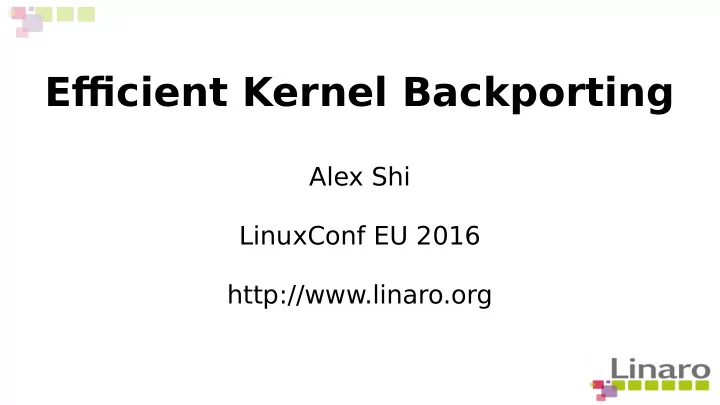

Effjcient Kernel Backporting Alex Shi LinuxConf EU 2016 http://www.linaro.org
Agenda ● Why do feature backporting ● Before backporting ● Feature organization ● Deal with Confmicts ● After backporting ● Expectations on upstream
Why do backporting
Why use old LTS ● Time to market product want kernel: Best stable kernel ● A target kernel as system baseline, for ● Out of tree patches – System compatibility – Less regression testing required ● A steady LTS
Feature Missed in LTS ● Latest feature missing Latest drivers, functions or security updates, like ● Arm64 PCI-E support on 3.18/4.1 – Cgroup writeback, hibernation on arm64, KASAN on 4.1 – Or out of tree features: – HMP/EAS on ARM for big LITTLE arch.
Solutions and Disadvantage ● Solution: LTS + feature backporting An example: Linaro Stable Kernel – ● https://wiki.linaro.org/LSK ● Perfect solution? No Repeated work for enabled feature – Less review/testing from community – Trouble with newer API or coupled kernel components –
Other Solutions? Keep rebasing on upstream kernel? Less stability ● kernel API change, like: driver API, /proc, /sys, ioctl ● Keep regression testing ●
Best Feature Candidate ● Good resources to know request feature Get feature info from requester, what/why ● Get feature profjle from lwn.net or wiki ● ● Know the feature versions First target is always the upstream patchset ● An old version feature maybe acceptable, if it's using old kernel API ●
How to do Backporting
Get Feature Commits ● Get feature patchset from lkml ● Collect feature commits in git tree From related source fjles and headers – ● Git log v4.1..upstream – drivers/base/power/opp If feature name mentioned – ● git log -i -G'kasan' v3.18..upstream (54 commits) ● git log -i --grep=kasan v3.18..upstream (126 commits) – By involved authors ● git log --author=tj@kernel.org --reverse v4.1.18
Feature Organization ● Rules for feature Organization Each of feature isolated in a separated branch ● Dependent feature based on others branch instead of LSK mainline ● Tree mode branches – A example: pax_usercopy rely on KASLR – ● Benefjt Feature Selectable ● Reading, retrieve and debug ●
Feature Organization ● An example of LSK organization: -----LTS 4.1.17 –-------- LTS 4.1.18 \ \ ------------- LSK 4.1 16.02 ----- LSK 4.1 16.03 / / ---LTS 4.1.17+ FooA / \ / FooB---------
Backporting with Git ● Pick up wanted changes/commits $git cherry-pick -sx commit1..commit2 git cherry-pick a patchset range ● Get all commit at once, easily disturbed by dependent missing. – git cherry-pick patches one by one. ● Easy to control for every commits –
Confmicts ● Middle changes missed confmicts Direct code base changed ● Like, removed line doesn't exist. – Know reasons of the changes by 'git log -S/Gstring', pick or skip – Miss some dependencies, ● Like some new code line in close section – Find and pick them by 'git blame' or 'git log -p' – Feature coupled with other kernel components ● Cut ofg the connection maybe better – Or bring trouble on the other kernel part –
T ool for Confmicts ● Confmicts solution reuse Use git rerere to reuse confmicts solutions – ● Find commits that trigger confmicts T ools git log, git blame – git log -G'extern void inet_twsk_put' – include/net/inet_timewait_sock.h git blame – drivers/base/power/opp/core.c
Reduce Confmicts ● Reduce confmicts Find out all related changes on feature related fjeld ● Pick up from base to upstream direction – Pick up the related set commits instead of only single ● related patch, Use gitk not git log --graph to fjnd out the commit set –
Feature/LTS Confmicts ● Example, a upstream situation: other blk/mm change / \ ------ 4.1 -- bug fjx f1 ----- confmicts -- v4.2 ---- bug fjx f2/f3 ---- \ / cgroup feature -- a -- b
Feature/LTS Confmicts ● Usual solution for cgroup writeback LTS branch: backported cgwb -- a' – b'-- c' / --- 4.1 -- 4.1.x ---- 4.1.18 / bug fjx f1/f2/f3
Feature/LTS Confmicts ● A better way, postpone confmicts to merge Do the backporting on v4.1 kernel, and left the confmicts ● on merging to 4.1.18 backported cgwb -- a -- b / \ --LTS 4.1 -- 4.1.x --------------- 4.1.18 / bug fjx f1/f2/f3
Don't Do ... ● Don't change kernel/user API /sys, /proc etc System libs, applications rely on them – ● Don't pick up big coupled kernel parts Cut ofg early – ● Don't change driver API Downstream drivers –
Post Backporting ● Review if all necessary commits picked Scan and compare all changed and related commits ● git log --cherry v4.4...v4.1/topic/KASAN -- ./mm/kasan ./include/confjg/have/arch/kasan.h ./include/linux/kasan.h ./arch/arm64/mm/kasan_init.c ./arch/arm64/include/asm/kasan.h ● T esting for the feature Seek testing method from community ●
Post Backporting ● Scan bug fjx for picked commits https://git.linaro.org/people/alex.shi/scripts.git/blob/HEAD:/chkfjx.sh The latest features are often buggy, so scan the upstream kernel, to see if any commits which you picked was mentioned by others, that's probably a bug fjx.
Post Backporting ● Notice your users of Any API changes if you have to do Explain reasons – And give compatible solution for changes –
Expectation for Upstream ● Stable ● The less API change, the better. Standardization of API? ● POSIX, Libcgroup, DRM, memfd, etc. – Driver API – keep old function when new ones introduced ● Good examples, cgroup v2 coexist with cgroup v1 – ● Collaboration on backporting LTSI/LSK –
Summary ● Why Backporting is a common needs in industry ● How to do backporting and how to resolve confmicts ● Standardization needs on upstream
Thanks!
Recommend
More recommend